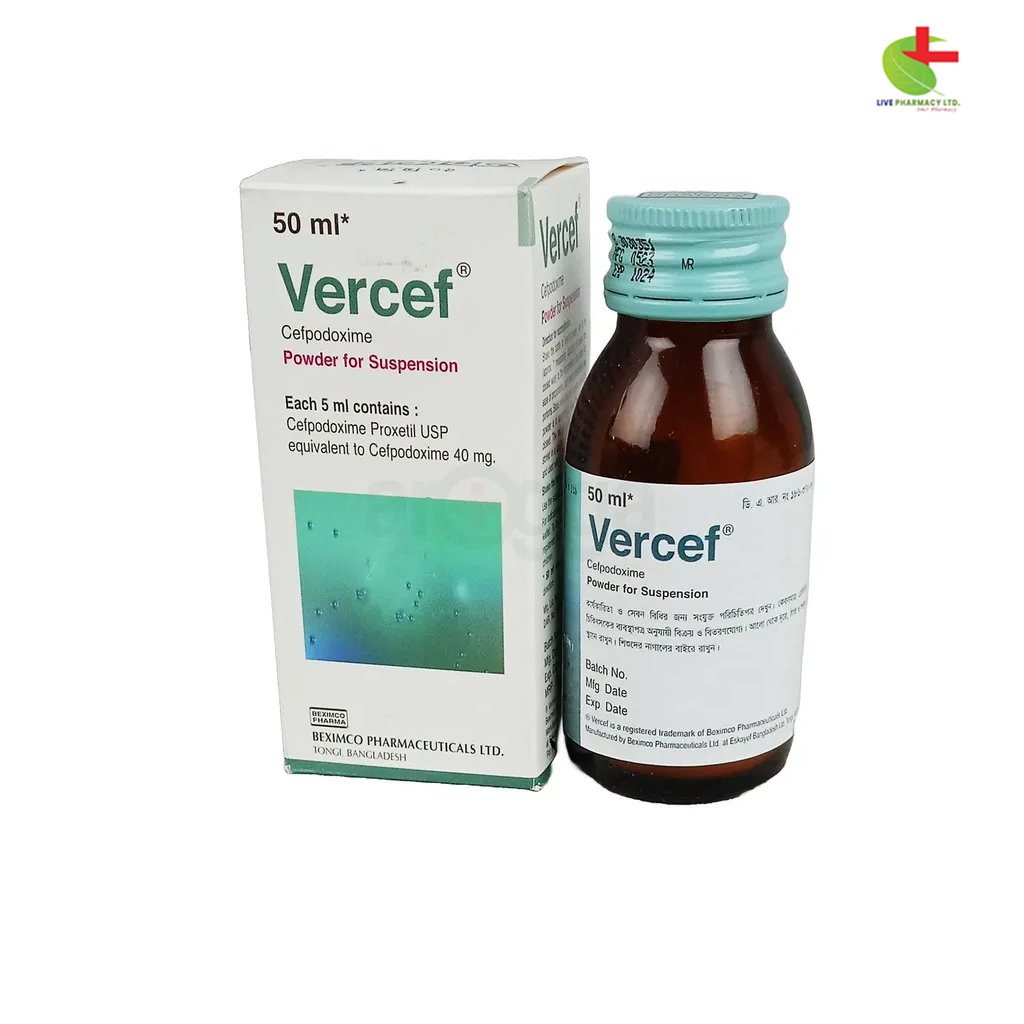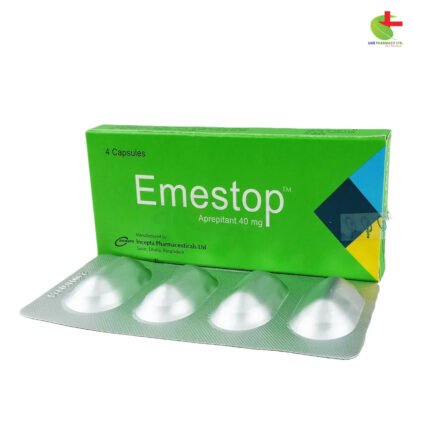Vercef 50ml
98.00৳ Bottle (50ml)
- Vercef DS is a third-generation cephalosporin effective against a range of bacterial infections, including otitis media, pharyngitis, sinusitis, and community-acquired pneumonia.
- It treats both Gram-positive and Gram-negative bacteria, including strains resistant to other antibiotics.
- The medication is available in various dosages for adults, adolescents, and children, with adjustments for renal impairment.
- Common side effects include gastrointestinal issues and skin infections; use with caution in patients with renal dysfunction.
 Brand
Brand
|
Beximco Pharmaceuticals Ltd |
|---|---|
 Generics
Generics
|
Cefpodoxime Proxetil |
 Type
Type
|
Powder for Suspension |
Indications
Vercef DS is prescribed for the treatment of infections caused by susceptible microorganisms, including:
- Acute Otitis Media: Effective against Streptococcus pneumoniae, Streptococcus pyogenes, Haemophilus influenzae, and Moraxella catarrhalis (including strains producing beta-lactamase).
- Pharyngitis/Tonsillitis: Targeting Streptococcus pyogenes.
- Acute Maxillary Sinusitis: Treats infections caused by Haemophilus influenzae (including beta-lactamase-producing strains), Streptococcus pneumoniae, and Moraxella catarrhalis.
- Community-Acquired Pneumonia: Effective against Streptococcus pneumoniae or Haemophilus influenzae (including strains producing beta-lactamase).
- Acute Bacterial Exacerbation of Chronic Bronchitis: Targeting Streptococcus pneumoniae, Haemophilus influenzae (only non-beta-lactamase-producing strains), and Moraxella catarrhalis.
- Skin and Skin Structure Infections: Treats infections caused by Staphylococcus aureus and Streptococcus pyogenes.
- Uncomplicated Urinary Tract Infections: Effective against Escherichia coli, Klebsiella pneumoniae, Proteus mirabilis, and Staphylococcus saprophyticus.
- Uncomplicated Gonorrhea: Treats Neisseria gonorrhoeae (including penicillinase-producing strains).
- Rectal Gonococcal Infections in Women: Targets Neisseria gonorrhoeae (including penicillinase-producing strains).
Pharmacology
Vercef DS contains Cefpodoxime, an oral third-generation cephalosporin known for its stability against beta-lactamases and its efficacy against both Gram-positive and Gram-negative bacteria. It is used to treat infections even before the specific pathogen is identified. Cefpodoxime, a prodrug, is metabolized to its active form, Cefpodoxime. Approximately 29-33% of Cefpodoxime is excreted unchanged in the urine within 12 hours.
Cefpodoxime is highly effective against a broad spectrum of susceptible microorganisms, demonstrating superior stability against beta-lactamase enzymes compared to other third-generation oral cephalosporins. It is effective against various Gram-positive and Gram-negative bacteria, including strains resistant to other antibiotics.
Dosage & Administration
Adults and Adolescents (13 years and older):
- Pharyngitis/Tonsillitis: 100 mg every 12 hours for 5 to 10 days.
- Acute Maxillary Sinusitis: 200 mg every 12 hours for 10 days.
- Community-Acquired Pneumonia: 200 mg every 12 hours for 14 days.
- Acute Bacterial Exacerbation of Chronic Bronchitis: 200 mg every 12 hours for 10 days.
- Skin and Skin Structure Infections: 400 mg every 12 hours for 7 to 14 days.
- Uncomplicated Urinary Tract Infection: 100 mg every 12 hours for 7 days.
- Uncomplicated Gonorrhea: Single dose of 200 mg.
- Rectal Gonococcal Infections in Women: Single dose of 200 mg.
Infants and Pediatric Patients (2 months to 12 years):
- Acute Otitis Media: 5 mg/kg body weight every 12 hours for 5 days.
- Pharyngitis/Tonsillitis: 5 mg/kg body weight every 12 hours for 5 to 10 days.
- Acute Maxillary Sinusitis: 5 mg/kg body weight every 12 hours for 10 days.
Renal Dysfunction: For severe renal impairment (creatinine clearance <30 ml/min), extend dosing intervals to every 24 hours.
Liver Cirrhosis: No dosage adjustment is needed for patients with liver cirrhosis.
Interactions
- Antacids: High doses of antacids or H2 blockers may reduce peak plasma levels of Cefpodoxime by 24-42% and absorption by 27-32%.
- Probenecid: Increases Cefpodoxime AUC by approximately 31% due to reduced renal excretion.
- Nephrotoxic Drugs: Monitor renal function closely when used with other nephrotoxic agents.
Contraindications
Cefpodoxime Proxetil should not be used in patients with a known allergy to Cefpodoxime or other cephalosporin antibiotics.
Side Effects
Common side effects include diarrhea, nausea, skin and vaginal fungal infections, abdominal pain, headache, chest pain, myalgia, dyspepsia, dizziness, vertigo, and cough. Fungal skin rashes may occur more frequently in children.
Pregnancy & Lactation
Animal studies have not shown teratogenic or embryocidal effects, but adequate studies in pregnant women are lacking. Use during pregnancy only if necessary. Cefpodoxime is excreted in breast milk; consider discontinuing breastfeeding or the drug based on clinical judgment.
Precautions & Warnings
In patients with reduced urinary output due to renal insufficiency, adjust the total daily dose of Vercef DS. Caution is advised when administering with potent diuretics. Prolonged use may lead to overgrowth of non-susceptible organisms; regular patient evaluation is recommended.
Therapeutic Class
Third-Generation Cephalosporins
Reconstitution
To prepare a 50 ml suspension, add 30 ml (6 teaspoonfuls or the provided cup) of cooled, boiled water to the powder in the bottle, adding water in two portions for ease. Shake well after each addition until the powder is fully dissolved. Shake well before each use. Store the reconstituted suspension in a cool, dry place or refrigerator, and discard any unused portion after 14 days.
Storage Conditions
Store in a dry place, protected from light and heat. Keep out of reach of children.













Reviews
There are no reviews yet.